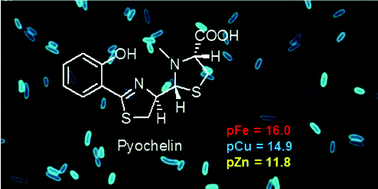Pyochelin, a siderophore of Pseudomonas aeruginosa: Physicochemical characterization of the iron(iii), copper(ii) and zinc(ii) complexes†
Abstract
Pseudomonas aeruginosa is an opportunistic pathogen, synthesizing two major

* Corresponding authors
a
Laboratoire de Physico-Chimie Bioinorganique, Institut de Chimie, UMR 7177 CNRS, Université de Strasbourg, ECPM, 25 rue Becquerel, Strasbourg, France
E-mail:
amalbre@chimie.u-strasbg.fr
Fax: 33 (0) 3 68 85 26 39
Tel: 33 (0) 3 68 85 26 38
b
Equipe «Transport Membranaires Bactériens» UMR 7242, Université de Strasbourg-CNRS, boulevard Sébastien Brant, BP 10413, Illkirch Cedex, France
E-mail:
mislin@unistra.fr
Fax: 33 (0) 3 68 85 48 29
Tel: 33 (0) 3 68 85 47 27
c Equipe Reconnaissance et Procédés de Séparation Moléculaire (RePSeM), UMR 7178, Université de Strasbourg-CNRS, IPHC, 25 rue Becquerel, Strasbourg, France
d Laboratoire de Chimie Bioorganique et Médicinale, UMR 7509 CNRS, Université de Strasbourg, ECPM, 25 rue Becquerel, Strasbourg, France
Pseudomonas aeruginosa is an opportunistic pathogen, synthesizing two major

 Please wait while we load your content...
Something went wrong. Try again?
Please wait while we load your content...
Something went wrong. Try again?
J. Brandel, N. Humbert, M. Elhabiri, I. J. Schalk, G. L. A. Mislin and A. Albrecht-Gary, Dalton Trans., 2012, 41, 2820 DOI: 10.1039/C1DT11804H
To request permission to reproduce material from this article, please go to the Copyright Clearance Center request page.
If you are an author contributing to an RSC publication, you do not need to request permission provided correct acknowledgement is given.
If you are the author of this article, you do not need to request permission to reproduce figures and diagrams provided correct acknowledgement is given. If you want to reproduce the whole article in a third-party publication (excluding your thesis/dissertation for which permission is not required) please go to the Copyright Clearance Center request page.
Read more about how to correctly acknowledge RSC content.
 Fetching data from CrossRef.
Fetching data from CrossRef.
This may take some time to load.
Loading related content
